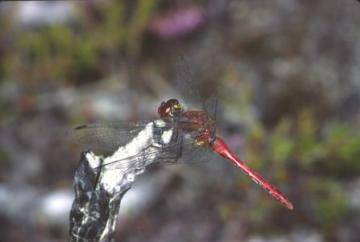Species Account for Sympetrum sanguineum
Sympetrum sanguineum Ruddy Darter
(Muller, 1764)
Odonata: Libellulidae

Reproduction for study and non-profit use permitted, all other rights reserved.
Taxonomic group: dragonflies & damselflies (Odonata) - Available county data
View time series maps for Sympetrum sanguineum
member log-on for taxon report
Essex RDB: Listed
Images
upload a new image
Species text
Sympetrum sanguineum is a bright red darter dragonfly with markedly 'club-tailed' abdomen. It has a south-eastern distribution in Britain and is rare in south-west England and Wales and becomes scarce in the north-Midlands extending as far north as Barnsley. It has shown a marked increase in abundance in recent decades and may be spreading northwards. It breeds in the marshy margins of ponds, lakes, old gravel and clay pits, canals and ditches where there is an abundance of tall emergent plants. It can tolerate quite brackish conditions and occurs in coastal grazing marshes where sea club rush is often dominant, and is often found in the company of Lestes dryas, using richly vegetated and brackish sites such as coastal and estuarine dykes choked with Sea Club-rush or Reed-mace (Benton 1988). References
Habitats
Recorded management for locations with Sympetrum sanguineum
Recorded substrate and hydrology for locations with Sympetrum sanguineum
Why not join the Club, register and add a new species page
Interpretation of distribution maps




















